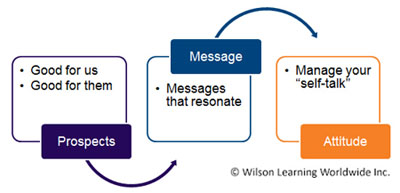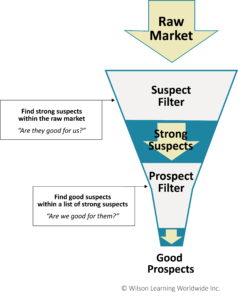Yet clearly, it’s vitally important to maintain a healthy pipeline of prospective business, especially when established customers are cutting budgets and delaying spending. So what’s the alternative to the traditional “dialing for dollars” approach?
 The “right” prospects, with the “right” message, while making sure you as a salesperson have the “right” attitude.
The “right” prospects, with the “right” message, while making sure you as a salesperson have the “right” attitude.
- Right Prospects: Cut through the numbers and make sure you are approaching only those prospects who are good for you, and you are good for them. Take the 30:1 suspect-to-sale ratio to 20:1, even 10:1!
- Right Message: Once you find the right prospects, make sure your message resonates, enabling you to gain access and position yourself as someone who can solve a problem for the prospect.
- Right Attitude: Finally, you need to make sure you take on the right attitude as a salesperson. How do you keep prospecting after getting rejected over and over again? The simple answer is you have to manage your “self talk”—the things you say inside your head that make the difference between success and feeling defeated.
In this article, we will examine the first element—the “right” prospects. We will look at a 4-step process on how to cut through the numbers and ensure you are talking to the “right” prospects.
4 Steps to Targeting the Right Prospects—Good for Us, Good for Them
Step 1: Stop Chasing Numbers
 Well-prepared, experienced professionals do not waste time calling on weak prospects. They identify the strongest prospects first by adopting a very different strategy focused on quality rather than quantity. By investing a little more time upstream, the yield downstream is not just a larger number of prospects, but a larger number of good prospects. These are the ones who are not only more likely to buy, they are more likely to buy from you.
Well-prepared, experienced professionals do not waste time calling on weak prospects. They identify the strongest prospects first by adopting a very different strategy focused on quality rather than quantity. By investing a little more time upstream, the yield downstream is not just a larger number of prospects, but a larger number of good prospects. These are the ones who are not only more likely to buy, they are more likely to buy from you.
The secret? Find the customers who meet two simple criteria: They are good for you, and you are good for them.
Step 2: Identify Quality Suspects
Rather than placing every possible company in a territory on an indiscriminate list of suspects, a screening process should take place. Based on the first of the criteria mentioned above, ask, “Which of these candidate prospects are most likely to be good for us?”
To answer this question, each “suspect” company should be carefully vetted through pre-call research, and compared to a profile identifying what’s most important for your organization in predicting the probability of a sale.
For example, you might be asking whether there is evidence that a company:
- Matches your economic and strategic priorities
- Has the right level of profitability and a probability of buying from you
- Matches your industry/market segment requirements
- Is in the right geographic location
- Has healthy annual sales/net income and is the right size
- Has the budget and ability to spend for what you sell
Once these questions have been answered for each suspect, the list should be sorted and companies that don’t meet the “good for us” criterion should be discarded. The remainder will constitute your short list of potential prospects.
By putting in the time to develop this higher-quality list, you can make earlier “go/no-go” decisions that will help you avoid expensive efforts to contact customers who are never going to buy from you.
Step 3: Find Your High-Quality Prospects
Remember, to make the short list of strong suspects, a company has to match the profile that describes a good prospective customer for your organization.
Before qualifying as good prospects, your suspects need to pass the second test: Are you good for them? This requires asking a different set of questions, focused on understanding how you can deliver high value a customer would be willing to pay for.
As a prerequisite to developing a final list of good prospects, you should be able to answer the following questions:
- What’s our unique value?
- What business problem do we solve?
- What are they able to do with our solution?
- What do we improve or increase? What do we decrease?
- What’s important to the customer?
Once the answers to these questions are clear, they should be linked or matched to each suspect on the list, and when a good match is found, that company should be promoted to the prospecting list.
Step 4: Select the “Quality Few” to Contact
If good information has been gathered to answer the critical questions about each potential suspect, the outcome should be a good, high-quality list of prospective customers. These are companies that have a high probability of being able to buy your solutions and are also likely to receive high business value from your solutions.
When you use this approach to select a small number of well-qualified companies to call, based on these criteria, you will be far more effective at building a strong business case for a meeting. Focusing on the right prospects increases the speed of appointment setting since your energy is directed toward high probability contacts who have a high likelihood of valuing what is offered. The result of escaping the numbers game is to decrease the suspect-to-prospect ratio, increase the prospect-to-sale ratio, and achieve an overall increase in the value of each new sale.
Right Prospects, Right Message, Right Attitude
Now that you have figured out the “right” prospects, you must create the right message that illustrates your understanding of their issue and ability to solve it. Underlying the entire process of prospecting is maintaining the “right” attitude to keep you motivated and focused amidst push back and rejection. These three elements are crucial to every prospecting effort; without them, you will find yourself stuck in the numbers trap.


 The “right” prospects, with the “right” message, while making sure you as a salesperson have the “right” attitude.
The “right” prospects, with the “right” message, while making sure you as a salesperson have the “right” attitude. Well-prepared, experienced professionals do not waste time calling on weak prospects. They identify the strongest prospects first by adopting a very different strategy focused on quality rather than quantity. By investing a little more time upstream, the yield downstream is not just a larger number of prospects, but a larger number of good prospects. These are the ones who are not only more likely to buy, they are more likely to buy from you.
Well-prepared, experienced professionals do not waste time calling on weak prospects. They identify the strongest prospects first by adopting a very different strategy focused on quality rather than quantity. By investing a little more time upstream, the yield downstream is not just a larger number of prospects, but a larger number of good prospects. These are the ones who are not only more likely to buy, they are more likely to buy from you.